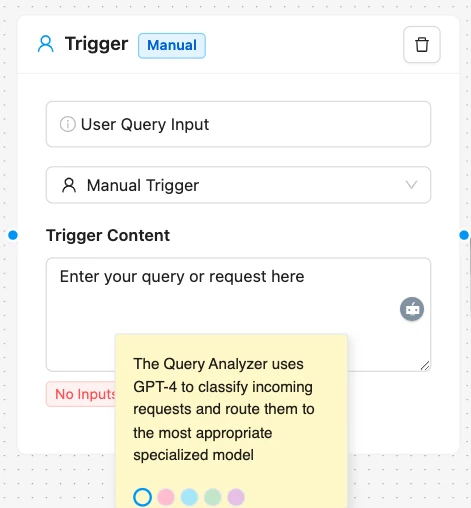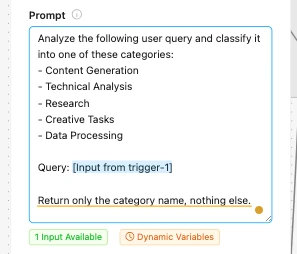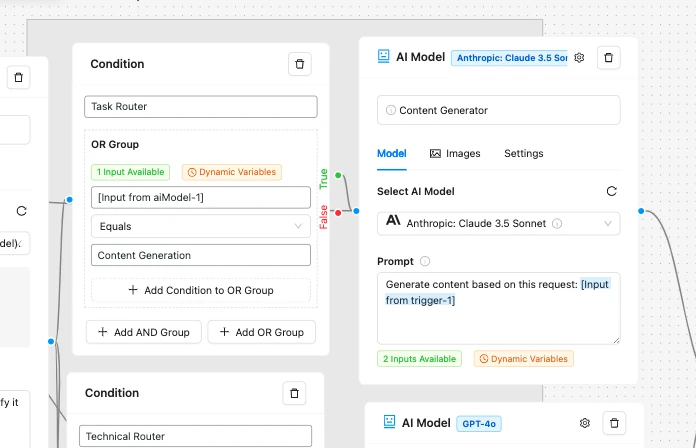Who Should Implement This AI Strategy?
Content creators, AI enthusiasts, developers, and site administrators looking to enhance user experiences with personalized, context-aware interactions on WordPress sites should implement this AI strategy. This local AI model router workflow is ideal for those who prioritize data privacy and seamless workflow integration, as it keeps data processing local within the WordPress ecosystem.
What Operational Hurdles Does This Overcome?
Traditional methods of AI model selection and routing often rely on external services or complex manual setups, which can compromise user data privacy and slow down operations. This local AI model router workflow overcomes the operational hurdles of manual intervention and external data transfer, ensuring a more streamlined, secure, and efficient process.
How Agentic AI Executes Tasks
Agentic AI within the AI Workflow Automation plugin executes tasks by dynamically selecting and routing queries to the most suitable AI model based on the user’s request. This intelligent automation relies on understanding the context and requirements of each query, thereby delivering tailored responses with high accuracy and speed.
Essential Plugin Features
-
- AI Model Node: Allows for the configuration and use of multiple AI models within the local AI model router workflow.
-
- WordPress Core Trigger: Initiates the agentic AI workflow based on specific WordPress events.
-
- Conditional Logic Node: Facilitates dynamic routing decisions based on conditional logic.
Building the Local AI Model Router for WordPress
Step 1: Trigger Setup
The first step in building your agentic AI workflow is configuring a WordPress Core Trigger or a Manual Trigger Node. This node allows you to initiate the workflow based on specific WordPress events such as user registration or post submission. By setting up the trigger correctly, you ensure that the local AI model router workflow activates seamlessly within your WordPress environment, adhering to integration standards and maintaining data privacy.

Step 2: AI Model Configuration
Next, integrate the AI Model Node to analyze incoming user requests. This node can be configured with multiple AI models, such as GPT-4 for text generation or Claude 3 for reasoning tasks, each tailored to different types of queries. By adjusting parameters like temperature and context window, you can optimize the performance of these models for various tasks, ensuring that your AI agent always selects the best model for each user’s needs.

Step 3: Action Implementation
The final step involves using the Conditional Logic Node to dynamically route the request to the appropriate AI model based on the nature of the task. This node evaluates the user input and applies task-specific conditions to ensure that the request is processed by the most suitable AI model within WordPress. This approach not only enhances the accuracy and speed of responses but also maintains user data privacy by avoiding external data transfer.

Customizing Your Local AI Model Router Workflow
To further tailor your agentic AI workflow, consider the following customization options:
-
- Model Selection: Experiment with different AI models to find the best fit for your specific use cases.
-
- Conditional Logic: Refine the conditions used in the Conditional Logic Node to improve routing accuracy.
-
- Trigger Events: Expand the list of WordPress events that can trigger your workflow to cover more user interactions.
For more inspiration and templates, visit our workflow templates page.
The Business Value of Agentic AI Workflows
Implementing an agentic AI workflow with the AI Workflow Automation plugin offers significant business value. It provides WordPress users with an intelligent AI routing system that allows for personalized and context-aware interactions without compromising user data privacy. By dynamically selecting the best AI model for each task, this workflow enhances user engagement, improves the accuracy and speed of responses, and maintains a cohesive user experience on the WordPress platform.
Conclusion
By leveraging the capabilities of the AI Workflow Automation plugin, you can build powerful agentic AI workflows that automate the selection and routing of AI models within WordPress. This not only streamlines operations and enhances user experiences but also ensures data privacy and security. Start implementing your local AI model router today and transform your WordPress site into a hub of intelligent, personalized interactions.